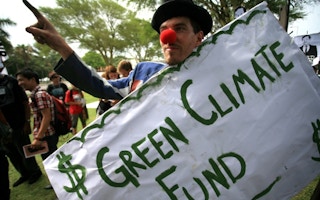This year will be marked as a significant one for the climate as the United States and China brokered a symbolic deal to tackle climate change a month before the United Nations climate change negotiations in Lima, Peru in December.
To continue reading, subscribe to Eco‑Business.
There's something for everyone. We offer a range of subscription plans.
- Access our stories and receive our Insights Weekly newsletter with the free EB Member plan.
- Unlock unlimited access to our content and archive with EB Circle.
- Publish your content with EB Premium.
At the climate conference in Peru, there was an absence of clear commitments from countries on exact carbon emission reduction targets, but progress was made on the Green Climate Fund to help developing countries prepare for climate change.
Meanwhile, green investments gained traction this year with the rise of investments into solar, green bonds and a global movement to divest from fossil fuels.
Here’s our pick of the top 5 major policy and finance developments for the year:
1. Securing $10 billion to finance climate change
The Green Climate Fund reached its target of US$10 billion to help developing countries cut their carbon emissions and adapt to climate change impacts. This commitment, reached at the UN climate negotiations at Peru in December, comes as new report reveals that spending on clean energy and climate protection measures has been dwindling over the past two years.
Christiana Figueres, executive secretary of the United Nations Framework Convention on Climate Change, said during the conference that the world needs at least $100 billion each year by 2020 to help vulnerable countries adapt to climate change impacts. Recipients of the money, however, do not yet have a clear timeline on how these funds will be disbursed.
2. The link between finance, policy and deforestation
A new report in January revealed that the forestry sector’s REDD+ programme would need US$12 billion to remain effective as a financing tool to reduce carbon emissions, halt deforestation and increase forest protection initiatives.
Separately, a study released by Carbon Disclosure Project revealed that companies are finding a strong business case for eliminating deforestation from their supply chains. Global consumer businesses that have made significant pledges to eliminate deforestation include L’Oreal, Japan-based Kao Corporation, United States multinationals Procter and Gamble, Krispy Kreme and Dunkin’ Donuts, and palm oil trader Golden Agri Resources.
Policy-wise, the year also saw Indonesia’s ratification of the Asean transboundary haze treaty, while Singapore passed a landmark Transboundary Haze Pollution Bill, which would impose fines of up to S$2 million on companies that are caught causing or contributing to transboundary haze pollution in Singapore. Meanwhile, Indonesia’s new president, Joko Widodo, has vowed to protect peatlands from being converted into plantations last November.
3. Divesting from fossil fuels
Divestment campaigns have grown worldwide, particularly in Australia, the only country in the world which has repealed its carbon tax law. The campaign has received robust support from universities, churches, banks and the global investment community.
A report compiled by the Overseas Development Institute and Oil Change International said the industry receives US$88 billion in support from G20 economies. This has not stopped philanthropic organisations, including the Rockefellers, to announce pledges to divest US$50 billion from fossil fuel companies.
4. The rise of green bonds
Green bonds have emerged this year as a popular form of financing clean technologies and low-carbon projects. Earlier this year, Bloomberg New Energy Finance already predicted a further rise in green bond issuances up to US$20 billion from 2013’s record US$13 billion as investments in renewable energy and clean transport increase.
The first of its kind green bond in Australia was issued this year, amounting to A$300 million. The National Australia Bank also launched this month the first climate bond in the local market with a A$150 million offering.
5. Carbon trading grows while CDM plummets
The sale of carbon credits through the 13-year old UN-back Clean Development Mechanism, where certified emissions reduction units can be bought to fund clean energy projects worldwide, have lost its value and credibility.
But carbon trading schemes, in contrast, have grown worldwide, according to a report by International Carbon Action Partnership in February. China, for example, launched a new emissions trading market this year and plans to launch a national carbon trading system by 2016. A CDP report in September also noted that an increasing number of big corporations expect governments worldwide to put a price on carbon dioxide emissions to help tackle climate change and some are already factoring in the cost to guide future investment decisions.
CDP said the report was the first global analysis of corporate views explicitly mentioning carbon pricing among the 6,000 company disclosures the group gathers annually. Around 40 nations and over 20 states, regions or cities have either set up or are planning to set up carbon pricing via taxes on emissions or by setting up emissions trading systems that cap emissions and allow companies to buy and sell permits to emit.
This story is part of our Year in Review series, which looks at the top stories that shaped the business and sustainability scene in each of our 11 categories.














